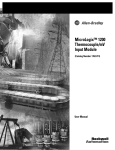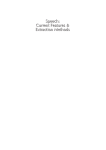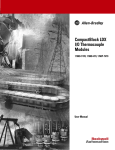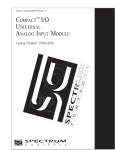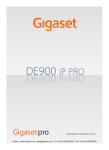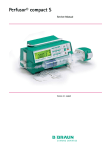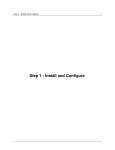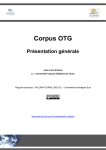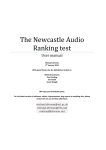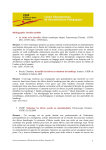Download Bonn Open Synthesis System (BOSS) 3
Transcript
Bonn Open Synthesis System (BOSS) 3 Documentation and User Manual December 20, 2005 Stefan Breuer, Petra Wagner, Julia Abresch, Jörg Bröggelwirth, Hannes Rohde and Karlheinz Stöber Contents 1 Introduction 1.1 History and Philosophy of BOSS . . . . . . . . . . . . . . . . 1.2 Credits . . . . . . . . . . . . . . . . . . . . . . . . . . . . . . . 4 4 5 2 Compiling BOSS from source 7 3 Installing and Using BOSS 3.1 Prerequisites . . . . . . . . . . . . 3.2 Client-Server model . . . . . . . . 3.3 Installing BOSS binaries . . . . . . 3.4 Installing the database . . . . . . . 3.4.1 The BOSS configuration file . . . . . . . . . . . . . . . . . . . . . . . . . . . . . . 9 . 9 . 9 . 10 . 11 . 12 4 General Architecture of BOSS 4.1 The BOSS client . . . . . . . . . . . . . . . . . . . 4.1.1 Minimal server XML document . . . . . . . 4.2 The BOSS server . . . . . . . . . . . . . . . . . . . 4.2.1 Overview . . . . . . . . . . . . . . . . . . . 4.3 Structure of the BOSS server . . . . . . . . . . . . Text pre-processing and prediction modules BOSS UnitSelection . . . . . . . . . . . . . BOSS cost functions . . . . . . . . . . . . . Concatenation and Manipulation . . . . . . . . . . . . . . . . . . . . . . . . . . . . . . . . . . . . . . . . . . . . . . . . . . . . . . . . . . . . . . . . . . . . . . . . . . . . . . . . . . . . . . . . . . . . . . . . . . . . 14 14 15 15 15 16 17 18 19 20 A The BOSS directory structure 24 B BOSS configuration files 26 C BOSS DE C.1 XML-Elements and Attributes . . . . . . . . . . . . . . . . . . C.1.1 Schema definition of a BOSS DE server document . . C.1.2 Schema definition of a BOSS DE inventory document C.1.3 Attribute and element creation order . . . . . . . . . . C.2 Configuration files and command line options . . . . . . . . . 27 27 27 32 36 39 2 D The GNU General Public License 40 D.1 The BOSS FLOSS exception . . . . . . . . . . . . . . . . . . 48 3 Chapter 1 Introduction 1.1 History and Philosophy of BOSS The Bonn Open Synthesis System (BOSS) is an architecture and software developed therefrom capable of producing synthetic speech. It was originally developed by Karlheinz Stöber. The goal of this software is to present developers of speech synthesis systems with an efficient and easy to expand software platform. The software excels especially at handling inventory elements of various sizes, such as words, syllables, phones and halfphones. BOSS uses a “non uniform unit selection”algorithm to select appropriate units from large corpora at runtime. It is conceived as a network application, which means that most of the synthesis procedure is hhandled by a BOSS server application that specialized clients can connect to in a standardized way. The BOSS system is free software under the GNU General Public License (GPL) with a special exception that allows software which is released under a GPL-incompatible license to be linked to by BOSS. It was developed in C++ on the GNU/Linux platform. BOSS is a further development of the synthesis concept of Verbmobil [Stöber et al.,1999], [Stöber et al.,2000]. As Verbmobil used a very specialized communication architecture employing a program called “testbed”which is not freely available, the first version of “BOSS”was developed in 2000. Just like Verbmobil, this software employed a blackboard architecture for internal communication. Data was held with the help of the GNU Data Base Manager (GDBM). Extended demands as well as problems with the flexibility of the blackboard and the database led to the development of the second version of BOSS, called BOSS II ([Klabbers et al.,2001a, Klabbers et al.,2001b, Stöber, 2003]). BOSS II differed from the original BOSS development in its employment of freely available software tools and use of standardized data formats, such as XML. The database backend was replaced by MySQL. The current third major version of BOSS features compatibility to recent versions of GCC 4 (3.0 and above) and the Xerces XML parser (2.4 and above), as well as enhanced portability by making use of the GNU build tools (autoconf, automake and libtool) and increased modularity and configurability by using dynamic loading of modules and XML-based configuration files. By now, the following applications of BOSS exist: • Adaptation to Dutch by Esther Klabbers, Raymond Veldhuis, Mathijs Visser and Karlheinz Stöber in 2001 ([Klabbers et al.,2001a]). • Adaptation to a directory enquiries front-end for klickTel GmbH by Julia Abresch and Stefan Breuer ([Breuer, Abresch, 2003, Hammerstingl, Breuer, 2003]) • Adaptation to Polish by Grazyna Demenko and Stefan Breuer ([Demenko, Grazyna 2003]) • Adaptation to British English in collaboration with Mark Huckvale (UCL) BOSS separates data and algorithms as much as possible. Therefore, it is easily possible to integrate and utilize various inventories. This separation is also the premise for the insertion of various languages. However, the use of languages other than the one originally intended requires modification of the algorithms. To make this portation as simple as possible, BOSS makes extensive use of object oriented programming. The developer who wants to port BOSS to a new language uses the transmission principle to integrate his required algorithms. This has to be done only in places requiring language specific modifications and is now facilitated by language-independent base classes which new modules can build upon. BOSS is a software platform which makes available elementary methods for the production of synthetic speech, thereby saving the developers time they can use for optimizing speech quality. BOSS is distributed with a fully functional German speech synthesizer (BOSS DE). Nevertheless, to adapt BOSS to languages other than German, developers will have to provide their own speech data as well as some language-specific synthesis modules. 1.2 Credits • BOSS server and libraries: Karlheinz Stöber, Stefan Breuer, Jörg Bröggelwirth, Philip Groß, Michal Holcı́k, Harald Ketzer, Mathijs Visser. • BOSS clients: Christian Weiß, Thilo Goldschmitz, Matthias Albrecht, Jörg Bröggelwirth, Michal Holcı́k, Stefan Breuer. 5 • Corpora: Petra Wagner, Lioba Faust, Michael Mennen, Daniela Schwill, Julia Abresch, Nadja Holder, Amanda Wildner, Meike Paulson, Katja Carapezza, Harald Ketzer, Valeska Maus, Bianca Aschenberner, Wenzel Borucki, Boris Glawe, Karlheinz Stöber, Esther Klabbers, Stefan Breuer. • Website(s) and Sourceforge presence: Christian Weiß, Hannes Rohde, Michal Holcı́k, Stefan Breuer 6 Chapter 2 Compiling BOSS from source This chapter explains the steps to compile a working binary program from the BOSS source code. If you have a binary distribution and just want to use BOSS without changing the program, feel free to skip to 3 for usage instructions. BOSS uses the GNU Build tools to ensure portability. However, BOSS has been designed with a UNIX-like platform in mind, more specifically, GNU/Linux. Thus, to be able to compile BOSS, your system must at least support POSIX system calls, either natively (as SunOS, BSD and other Unix variants do) or through additional software (e.g. Cygwin for MS Windows). So far, BOSS has been successfully compiled on SuSE, RedHat, Gentoo and Ubuntu Linux, as well as on SunOS. See 3.1 for a list of libraries that are needed for compilation and execution of BOSS. To configure the source tree for compilation, BOSS uses the GNU autotools: • autoconf (http://http://www.gnu.org/software/autoconf/), • automake (http://http://www.gnu.org/software/automake/) and • libtool (http://http://www.gnu.org/software/libtool/). When all required packages have been installed, please extract the BOSS source distribution archive to a directory of your choice, e.g.: user@host:~/$ tar xfvz boss-3.0.0-2.tar.gz In the next step, the BOSS compilation process should be prepared with the commands user@host:~/boss-3.0.0-1/$ ./bootstrap user@host:~/boss-3.0.0-1/$ ./configure If you are a developer of BOSS, you might want to install BOSS to a different location than the default /usr/local. In that case, use: 7 user@host:~/boss-3.0.0-1/$ ./configure --prefix=’desired_location’ ,then user@host:~/boss-3.0.0-1/$ ./export LD_LIBRARY_PATH ‘‘desired_location’’ to point to a directory that is not in the library search path. After these commands have completed successfully, compilation of the BOSS package can then be initiated with user@host:~/boss-3.0.0-1/$ make Depending on the configuration of your machine, the compilation process for the whole package can take several minutes. In case you want to repeat the compilation after changing your system (e.g. by upgrading libraries), it is good practice to clean up any possible remains from earlier compilations by executing user@host:~/$ make clean The last step - the installation of the compiled BOSS package - requires root privileges, so make you sure you have all permissions (i.e. by logging in as root or by prefixing the command with sudo): user@host:~/boss-3.0.0-1/$ make install If you want to remove the BOSS installation from your system at a later point, you can reverse the steps of ’make install’ by executing user@host:~/$ make uninstall This step - just like ’make install’ - requires root privileges, so again make sure to either log in as root or to use sudo if you are logged in as an unprivileged user. 8 3. You may copy and distribute the Program (or a work based on it, under Section 2) in object code or executable form under the terms of Sections 1 and 2 above provided that you also do one of the following: (a) Accompany it with the complete corresponding machine-readable source code, which must be distributed under the terms of Sections 1 and 2 above on a medium customarily used for software interchange; or, (b) Accompany it with a written offer, valid for at least three years, to give any third party, for a charge no more than your cost of physically performing source distribution, a complete machinereadable copy of the corresponding source code, to be distributed under the terms of Sections 1 and 2 above on a medium customarily used for software interchange; or, (c) Accompany it with the information you received as to the offer to distribute corresponding source code. (This alternative is allowed only for noncommercial distribution and only if you received the program in object code or executable form with such an offer, in accord with Subsection b above.) The source code for a work means the preferred form of the work for making modifications to it. For an executable work, complete source code means all the source code for all modules it contains, plus any associated interface definition files, plus the scripts used to control compilation and installation of the executable. However, as a special exception, the source code distributed need not include anything that is normally distributed (in either source or binary form) with the major components (compiler, kernel, and so on) of the operating system on which the executable runs, unless that component itself accompanies the executable. If distribution of executable or object code is made by offering access to copy from a designated place, then offering equivalent access to copy the source code from the same place counts as distribution of the source code, even though third parties are not compelled to copy the source along with the object code. 4. You may not copy, modify, sublicense, or distribute the Program except as expressly provided under this License. Any attempt otherwise to copy, modify, sublicense or distribute the Program is void, and will automatically terminate your rights under this License. However, parties who have received copies, or rights, from you under this License will not have their licenses terminated so long as such parties remain in full compliance. 43 5. You are not required to accept this License, since you have not signed it. However, nothing else grants you permission to modify or distribute the Program or its derivative works. These actions are prohibited by law if you do not accept this License. Therefore, by modifying or distributing the Program (or any work based on the Program), you indicate your acceptance of this License to do so, and all its terms and conditions for copying, distributing or modifying the Program or works based on it. 6. Each time you redistribute the Program (or any work based on the Program), the recipient automatically receives a license from the original licensor to copy, distribute or modify the Program subject to these terms and conditions. You may not impose any further restrictions on the recipients’ exercise of the rights granted herein. You are not responsible for enforcing compliance by third parties to this License. 7. If, as a consequence of a court judgment or allegation of patent infringement or for any other reason (not limited to patent issues), conditions are imposed on you (whether by court order, agreement or otherwise) that contradict the conditions of this License, they do not excuse you from the conditions of this License. If you cannot distribute so as to satisfy simultaneously your obligations under this License and any other pertinent obligations, then as a consequence you may not distribute the Program at all. For example, if a patent license would not permit royalty-free redistribution of the Program by all those who receive copies directly or indirectly through you, then the only way you could satisfy both it and this License would be to refrain entirely from distribution of the Program. If any portion of this section is held invalid or unenforceable under any particular circumstance, the balance of the section is intended to apply and the section as a whole is intended to apply in other circumstances. It is not the purpose of this section to induce you to infringe any patents or other property right claims or to contest validity of any such claims; this section has the sole purpose of protecting the integrity of the free software distribution system, which is implemented by public license practices. Many people have made generous contributions to the wide range of software distributed through that system in reliance on consistent application of that system; it is up to the author/donor to decide if he or she is willing to distribute software through any other system and a licensee cannot impose that choice. This section is intended to make thoroughly clear what is believed to be a consequence of the rest of this License. 44 8. If the distribution and/or use of the Program is restricted in certain countries either by patents or by copyrighted interfaces, the original copyright holder who places the Program under this License may add an explicit geographical distribution limitation excluding those countries, so that distribution is permitted only in or among countries not thus excluded. In such case, this License incorporates the limitation as if written in the body of this License. 9. The Free Software Foundation may publish revised and/or new versions of the General Public License from time to time. Such new versions will be similar in spirit to the present version, but may differ in detail to address new problems or concerns. Each version is given a distinguishing version number. If the Program specifies a version number of this License which applies to it and “any later version”, you have the option of following the terms and conditions either of that version or of any later version published by the Free Software Foundation. If the Program does not specify a version number of this License, you may choose any version ever published by the Free Software Foundation. 10. If you wish to incorporate parts of the Program into other free programs whose distribution conditions are different, write to the author to ask for permission. For software which is copyrighted by the Free Software Foundation, write to the Free Software Foundation; we sometimes make exceptions for this. Our decision will be guided by the two goals of preserving the free status of all derivatives of our free software and of promoting the sharing and reuse of software generally. N O WARRANTY 11. B ECAUSE THE PROGRAM IS LICENSED FREE OF CHARGE , THERE IS NO WARRANTY FOR THE PROGRAM , TO THE EXTENT PERMITTED BY APPLICABLE LAW. E XCEPT WHEN OTHERWISE STATED IN WRITING THE COPYRIGHT HOLDERS AND / OR OTHER PARTIES PROVIDE THE PRO GRAM “ AS IS ” WITHOUT WARRANTY OF ANY KIND, EITHER EXPRESSED OR IMPLIED, INCLUDING , BUT NOT LIMITED TO, THE IMPLIED WAR RANTIES OF MERCHANTABILITY AND FITNESS FOR A PARTICULAR PUR POSE . T HE ENTIRE RISK AS TO THE QUALITY AND PERFORMANCE OF THE PROGRAM IS WITH YOU. S HOULD THE PROGRAM PROVE DEFEC - TIVE , YOU ASSUME THE COST OF ALL NECESSARY SERVICING , REPAIR OR CORRECTION . 12. I N NO EVENT UNLESS REQUIRED BY APPLICABLE LAW OR AGREED TO IN WRITING WILL ANY COPYRIGHT HOLDER , OR ANY OTHER PARTY 45 WHO MAY MODIFY AND / OR REDISTRIBUTE THE PROGRAM AS PERMITTED ABOVE , BE LIABLE TO YOU FOR DAMAGES , INCLUDING ANY GEN ERAL , SPECIAL , INCIDENTAL OR CONSEQUENTIAL DAMAGES ARISING OUT OF THE USE OR INABILITY TO USE THE PROGRAM ( INCLUDING BUT NOT LIMITED TO LOSS OF DATA OR DATA BEING RENDERED INAC CURATE OR LOSSES SUSTAINED BY YOU OR THIRD PARTIES OR A FAIL URE OF THE PROGRAM TO OPERATE WITH ANY OTHER PROGRAMS ), EVEN IF SUCH HOLDER OR OTHER PARTY HAS BEEN ADVISED OF THE POSSIBILITY OF SUCH DAMAGES . E ND OF T ERMS AND C ONDITIONS Appendix: How to Apply These Terms to Your New Programs If you develop a new program, and you want it to be of the greatest possible use to the public, the best way to achieve this is to make it free software which everyone can redistribute and change under these terms. To do so, attach the following notices to the program. It is safest to attach them to the start of each source file to most effectively convey the exclusion of warranty; and each file should have at least the “copyright” line and a pointer to where the full notice is found. one line to give the program’s name and a brief idea of what it does. Copyright (C) yyyy name of author This program is free software; you can redistribute it and/or modify it under the terms of the GNU General Public License as published by the Free Software Foundation; either version 2 of the License, or (at your option) any later version. This program is distributed in the hope that it will be useful, but WITHOUT ANY WARRANTY; without even the implied warranty of MERCHANTABILITY or FITNESS FOR A PARTICULAR PURPOSE. See the GNU General Public License for more details. You should have received a copy of the GNU General Public License along with this program; if not, write to the Free Software Foundation, Inc., 59 Temple Place - Suite 330, Boston, MA 02111-1307, USA. 46 Also add information on how to contact you by electronic and paper mail. If the program is interactive, make it output a short notice like this when it starts in an interactive mode: Gnomovision version 69, Copyright (C) yyyy name of author Gnomovision comes with ABSOLUTELY NO WARRANTY; for details type ‘show w’. This is free software, and you are welcome to redistribute it under certain conditions; type ‘show c’ for details. The hypothetical commands show w and show c should show the appropriate parts of the General Public License. Of course, the commands you use may be called something other than show w and show c; they could even be mouse-clicks or menu items—whatever suits your program. You should also get your employer (if you work as a programmer) or your school, if any, to sign a “copyright disclaimer” for the program, if necessary. Here is a sample; alter the names: Yoyodyne, Inc., hereby disclaims all copyright interest in the program ‘Gnomovision’ (which makes passes at compilers) written by James Hacker. signature of Ty Coon, 1 April 1989 Ty Coon, President of Vice This General Public License does not permit incorporating your program into proprietary programs. If your program is a subroutine library, you may consider it more useful to permit linking proprietary applications with the library. If this is what you want to do, use the GNU Library General Public License instead of this License. 47 D.1 The BOSS FLOSS exception The University of Bonn, IKP Exception for Free/Libre and Open Source Software-only Applications used with the Bonn Open Synthesis System (the ”BOSS FLOSS Exception”). Exception Intent We want specified Free/Libre and Open Source Software (”FLOSS”) applications to be able to use specified GPL-licensed MySQL client libraries (the ”Program”) despite the fact that not all FLOSS licenses are compatible with version 2 of the GNU General Public License (the ”GPL”). Legal Terms and Conditions As a special exception to the terms and conditions of version 2.0 of the GPL: You are free to distribute a Derivative Work that is formed entirely from the Program and one or more works (each, a ”FLOSS Work”) licensed under one or more of the licenses listed below in section 1, as long as: 1. You obey the GPL in all respects for the Program and the Derivative Work, except for identifiable sections of the Derivative Work which are not derived from the Program, and which can reasonably be considered independent and separate works in themselves, 2. all identifiable sections of the Derivative Work which are not derived from the Program, and which can reasonably be considered independent and separate works in themselves, 1. are distributed subject to one of the FLOSS licenses listed below, and 2. the object code or executable form of those sections are accompanied by the complete corresponding machine-readable source code for those sections on the same medium and under the same FLOSS license as the corresponding object code or executable forms of those sections, and 3. any works which are aggregated with the Program or with a Derivative Work on a volume of a storage or distribution medium in accordance with the GPL, can reasonably be considered independent and separate works in themselves which are not derivatives of either the Program, a Derivative Work or a FLOSS Work. If the above conditions are not met, then the Program may only be copied, modified, distributed or used under the terms and conditions of the GPL or another valid licensing option from University of Bonn, IKP. 1. FLOSS License List License name Version(s)/Copyright Date Academic Free License 2.0 Apache Software License 1.0/1.1/2.0 Apple Public Source License 2.0 Artistic license From Perl 5.8.0 BSD license ”July 22 1999” Common Public License 1.0 GNU Library or ”Lesser” General Public License (LGPL) 2.0/2.1 Jabber Open Source License 1.0 MIT License (As listed in file MIT-License.txt) - Mozilla Public License (MPL) 1.0/1.1 Open Software License 2.0 PHP License 3.0 Python license (CNRI Python License) Python Software Foundation License 2.1.1 Sleepycat License ”1999” W3C License ”2001” X11 License ”2001” Zlib/libpng License - Zope Public License 2.0 48 Due to the many variants of some of the above licenses, we require that any version follow the 2003 version of the Free Software Foundation’s Free Software Definition (http://www.gnu.org/philosophy/free-sw.html) or version 1.9 of the Open Source Definition by the Open Source Initiative (http://www.opensource.org/docs/definitio 2. Definitions 1. Terms used, but not defined, herein shall have the meaning provided in the GPL. 2. Derivative Work means a derivative work under copyright law. 3. Applicability This FLOSS Exception applies to all Programs that contain a notice placed by University of Bonn, IKP saying that the Program may be distributed under the terms of this FLOSS Exception. If you create or distribute a work which is a Derivative Work of both the Program and any other work licensed under the GPL, then this FLOSS Exception is not available for that work; thus, you must remove the FLOSS Exception notice from that work and comply with the GPL in all respects, including by retaining all GPL notices. You may choose to redistribute a copy of the Program exclusively under the terms of the GPL by removing the FLOSS Exception notice from that copy of the Program, provided that the copy has never been modified by you or any third party. Version 0.1, 6 January 2005 This exception statement is based on “The MySQL AB Exception for Free/Libre and Open Source Software-only Applications Using MySQL Client Libraries (the ”FLOSS Exception”)” which can be found under http://www.mysql.com/company/legal/lice exception.html 49















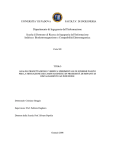

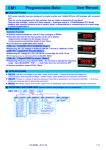

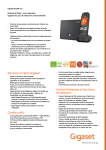
![[incr tsdb()]](http://vs1.manualzilla.com/store/data/005780303_1-7064634619abc733efac654e2a82e90d-150x150.png)
